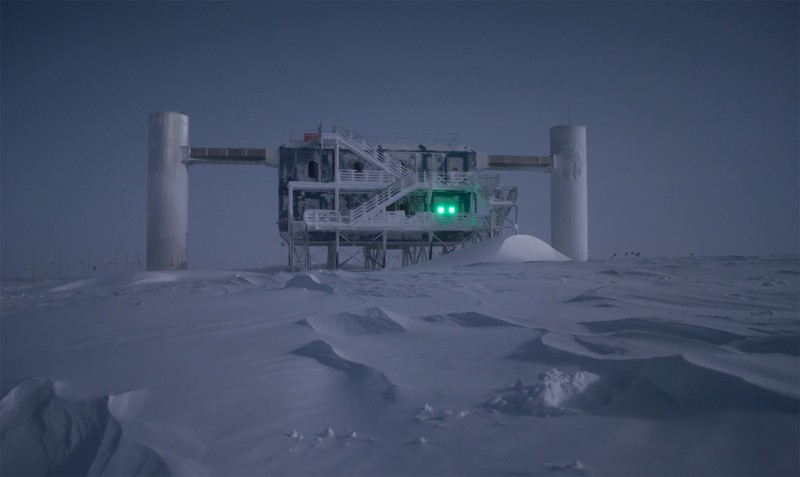

Moscow-based photographer Alexander Khokhlov and makeup artist Valeriya Kutsan are making portraits that use model's faces to create optical illusions. One series of these portraits is called "2D or Not 2D". This one isn't from that series, but it still could deserve that title!

This is the IceCube Neutrino Observatory in Antarctica. Actually most of it is deep under the ice. Almost 90 wires, each with 60 detectors attached, were lowered into holes melted in the ice using a hot water drill. And recently they've found some neutrinos with astoundingly high energies — up to 1 PeV!
I should explain that. An electron volt is how much energy an electron gets when it moves through a wire where the electric potential changes by one volt. A PeV is a peta-electron volt, or 1,000,000,000,000,000 electron volts... that's a 1 with 15 zeros after it.
But you still may not get how impressive it is for a neutrino to have that much energy. So let's go through some examples... and then I'll explain how a neutrino gets this much energy!
If you look at something orange, a bunch of orange photons are hitting your eye. Each one has an energy about about 2 electron volts. To pull the electron off a cold hydrogen atom takes 13.6 electron volts. These are the kind of energies we see in chemistry.
When they use X-rays to scan your luggage at the airport, it gets hit with lots of photons having over 100,000 electron volts of energy each.
When an electron hits its antiparticle and they annihilate, they turn into photons having a total of two times 511,000 electron volts of energy. In other words: mass can turn into energy, and the mass of an electron equals 511,000 electron volts of energy!
A proton is a lot heavier than an electron. When a proton hits its antiparticle and they annihilate, we get two times 938,000,000 electron volts of energy. A MeV is a million electron volts. So, that's 938 MeV.
The recently discovered Higgs boson is a lot heavier than a proton! To make a Higgs boson, you need about 125,000,000,000 electron volts of energy. A GeV is a billion electron volts. So, that's 125 GeV.
The particle accelerator used to make the Higgs boson can collide protons that have an energy of roughly 3 trillion electron volts: that's 3 TeV. People often say a flying mosquito has an energy of roughly one TeV. If so, this accelerator makes protons with the energy of three flying mosquitos! It doesn't sound like much until you realize it's all packed into a single particle.
A neutrino is an extremely light particle, much lighter than an electron. But Ice Cube has found neutrinos coming from space with energies up to 1,000,000,000,000,000 electron volts. That's a quadrillion electron volts, or a PeV. In other words: the energy of about a thousand flying mosquitos, packed into a single neutrino!
How do neutrinos get so energetic? The best guess is that even more energetic protons shooting through space hit photons from the cosmic background radiation, causing a reaction that makes neutrinos. These high-energy protons are called cosmic rays.
When I last checked, the most energetic cosmic ray ever seen was detected in 1994, when folks at the Fly's Eye cosmic ray detector in Utah observed one whose energy was about 320,000,000,000,000,000,000 electron volts. That's 320 quintillion electron volts, or 320 EeV. That's about the energy of a one-kilogram mass moving at 10 meters/second, all packed into one proton!
So, the next question is: why there are protons shooting through space at such high energies? But that's a question for another day.
Here's the new discovery:
Let me check the claim that a flying mosquito has a kinetic energy of 1 TeX — I got it from Wikipedia, but that doesn't mean it's true! According to the American Mosquito Control Association, the smaller mosquitos found around the house weigh about 2.5 milligrams. And according to a paper online, a fast mosquito flies 10 centimeters per second — this was hard to estimate because they fly in an irregular pattern, but that's another story. This paper also talks about mosquitos weighing 1 milligram, so I'm going to use that figure for a round number.
Kinetic energy is one half mass times velocity squared. So, the kinetic energy of such a mosquito is half of a millionth of a kilogram times (0.1 meters/second)2, or 5 × 10-9 joules.
But a TeV is 1.6 × 10-7 joules! So in fact this estimate is fairly bad.
Even if we use heavier mosquitos, weighing 2.5 milligrams, we only get 1.2 × 10-8 joules. They'd have to also fly 6 times as fast to get an energy of a TeV.
The paper I used sounds like a famous martial arts movie:
© 2013 John Baez
baez@math.removethis.ucr.andthis.edu